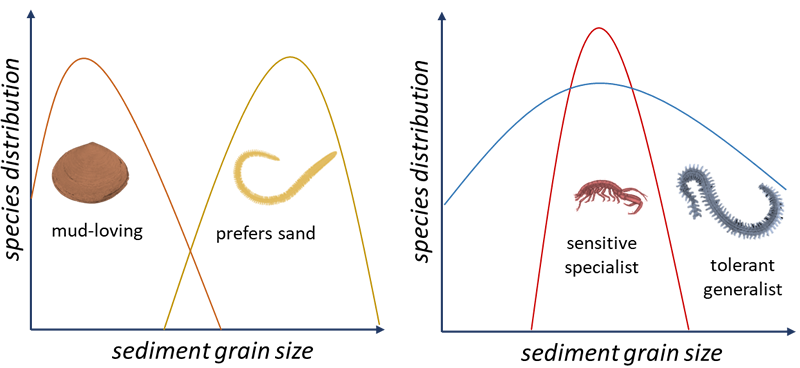T.J. Koositra1*, R. Witbaard1, K. Soetaert1, T.J. Bouma1, S.G. Pearson2
1 Royal Netherlands Institute for Sea Research; 2 Delft University of Technology
*corresponding author:
Introduction
The composition of benthic communities is strongly associated with the particle size of the sediment they are found in. Particle size depends on the environmental forcing that the sediment is exposed to. As such, sea level rise, increased occurrence of storms, and changes in sediment supply could drive coarsening of currently muddy coastal sediments. Benthic fauna are thus expected to be affected by this 'sandification'. Species-sediment relationships allow the prediction of how these changes may be manifested. We explore quantile-regression models to obtain detailed species-sediment relations for a Wadden Sea tidal basin, with the purpose to identify sensitivity of benthic communities to changes in sediment composition. Such detailed knowledge of area-specific sensitivity is needed if we want to inform coastal management decisions, for instance on the consequences of sediment nourishments.
Methods
Quantile regression models give a complete view of a species' distribution over an environmental variable range and take into account different response rates for the lower and the higher ends of the distribution. The top quantiles reflect the optimum habitat for the species, where limitations from other environmental constraints are minimized. Non-linear quantile regression models are fitted to benthos biomass and abundance data collected from the Ameland Inlet and ebb-tidal delta. Within this dataset, environmental gradients from inter- to subtidal and from muddy to sandy sediments are covered. Species-specific sediment relations are classified from generalists to specialists, and from mud- to sand-loving. These parameters are summarised per community and per area.
Results
Here we present our first results on sandification sensitivity per species, community and sub-area. The modelled predictions for species abundance and biomass over sediment gradients are used to determine changes in abundance, biomass and community composition at different levels of coarsening over the study area. Eventually, these results will be implemented in an online tool to illustrate benthos responses to changes in sediment composition.

Figure 1: Conceptual figure of benthic species' sediment preferences and tolerance to coarsening. Left: the clam Scrobicularia plana (brown) is an a mud-loving species, while catworm Nephtys cirrosa (yellow) is found in coarse sediments. Right: while ragworm Hediste diversicolor (blue) occurs over a wide range of sediment textures, the mud shrimp Corophium voluntator (red) has a very narrow distribution.
I. Surname1*, F.N. Another-Surname2 , Y. Next-Surname2
1 University Name, Country; 2 Organization Name, Country
* Corresponding author: mail.name@organization.org


